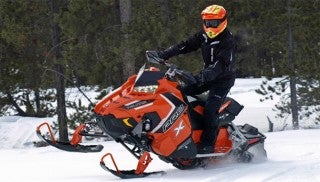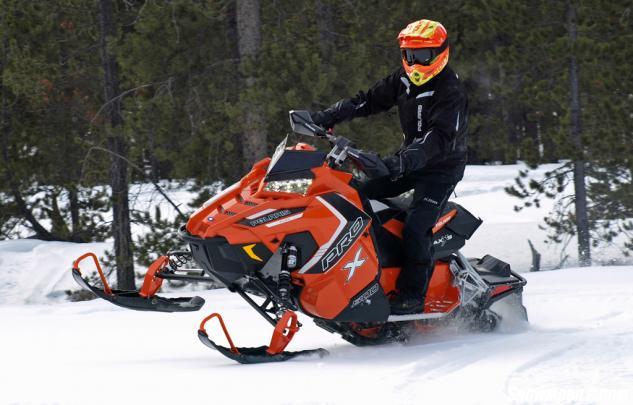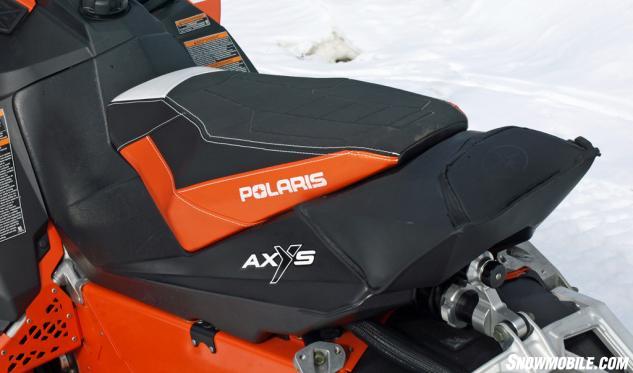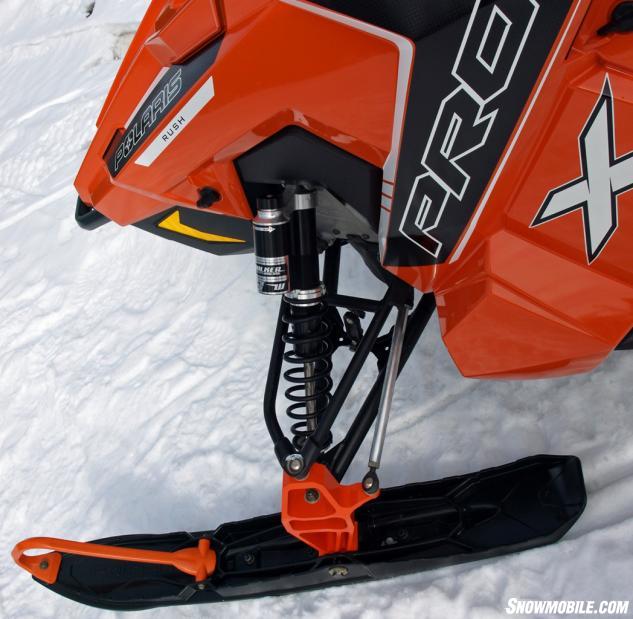2016 Polaris 800 Rush Pro-X 1.75 Review

One of the best straight ahead big bump power sleds you can buy
Let’s cut to the chase, the 2016 Polaris 800 Rush Pro-X with the deep-lugged Backcountry X track will be one of the best straight-ahead big bump sleds you can buy. It’s not the best Polaris Rush. We still feel that the 800 Rush Pro-S remains the best every day ride that Polaris offers.
We know that those of you who bought the Rush Pro-X disagree. That’s your right and we acknowledge that. And kind of agree – if your everyday riding style consists of seeking out and flying over the biggest, deepest bumps you can find. If you are the rougher-the-better kind of rider, then, yes! The Pro-X works for you. You are the 10 to 15 percent of hardest core snowmobilers for whom Polaris designed this sled. The larger majority of performance trail riders will choose what we consider to be the more versatile Pro-S.
 Big bumps and rough off trail running is what Rush Pro-X riders seek out.
Big bumps and rough off trail running is what Rush Pro-X riders seek out.The 2016 Polaris 800 Rush Pro-X 1.75 is serious business. It is as close as Polaris gets to a full-fledged race replica or ultimate ditch banger for the short track rider. This model compares to Ski-Doo’s MXZ X-RS and MXZ X versions for bump compatibility. And, like the Ski-Doo models, the Polaris offers exclusive features aimed directly at hardcore big bump riders.
For one thing, the Rush Pro-X comes with only one engine choice in the North American market, the Cleanfire 800 Twin. There will be a 600cc engine choice for international markets. Plus, the Rush Pro-X will only be available as an early season purchase. So, if you want one, get your checkbook out and put down a deposit before April 14th!
COMPARISON: Read our review of the 2015 Polaris 800 Rush Pro-S + Video
While we test rode the 2016 800 Rush Pro-X with the 1.75 Backcountry X track, you can order the 800 Pro-X with either the 1.25-inch lugged Ripsaw II or 1.35-inch Cobra track and save about $200. That choice is yours, but if you travel in the frequent snows of places like Michigan’s Upper Peninsula, you might go for the 1.75 track.
 The AXYS Performance Seat accommodates your movements forward to gain ski bite or rearward to gain more track bite and lighten the front end.
The AXYS Performance Seat accommodates your movements forward to gain ski bite or rearward to gain more track bite and lighten the front end.Regardless of the track footprint you put down, know that it chews snow from a satisfactorily potent Polaris engineered and manufactured Cleanfire two-stroker. In the confines of West Yellowstone, Montana, the 795cc semi-direct electronically injected twin relinquishes a bit of its total power to West’s 6,000-plus feet of elevation. At sea level the 800 immediately sets you back on the saddle when you grab a handful of throttle!
This past winter – or, what passed for it in our area – we enjoyed the use of a 600cc Switchback Adventure on our occasionally available favorite trails. Quite content with the 600 at sea level, we borrowed a friend’s 800 Rush for a few miles. Whoa! What ran quite well at West Yellowstone runs far better at our 880-foot elevation. Hold on!
Power is not a problem with the 2016 800 Rush Pro-X. We have read various forum reports that dyno tests of the engine show it down to competitors. Could be. Polaris doesn’t deny that its Cleanfire 800 isn’t the most powerful two-stroke you can get. But, Polaris engineers are quite adamant that the 800 Rush Pro-X competes very well head-to-head in acceleration testing. They feel that way because their 800 twin pulls a lighter sled. Polaris claims the Rush Pro-X weighs in at 435 pounds (dry). Ski-Doo’s MXZ X-RS 800 has a published weight of 470 pounds; the MXZ X weighs 475 pounds. At worst the Polaris should be close in power-to-weight ratio.
 With excellent power to weight and crisp action from the 800cc twin, grabbing a handful of throttle makes the 800 Rush Pro-X jump.
With excellent power to weight and crisp action from the 800cc twin, grabbing a handful of throttle makes the 800 Rush Pro-X jump.We also suspect that the Polaris 800 Rush Pro-X gains an advantage in the drivetrain, which features Polaris’ historically efficient P-85 drive clutch combined with a Team LWT driven. Those Team components must work as Arctic Cat has switched over to a complete Team drive system for 2016. Plus, from personal experience over our many years, we have seen Polaris clutching make up for horsepower shortfalls on cross country racing sleds, beating out more powerful sleds – on paper at least!
With equivalent performance, how else does the Pro-X satisfy big bump riders? For starters, Polaris breaks from the Ski-Doo camp of rider-forward, which every manufacturer has copied since the REV was first introduced a decade ago. Even Ski-Doo has refined its ride-forward. Polaris claims to have blown past that popular rider-friendly setup by creating “rider balanced” positioning that places you in the center of a pivoting fulcrum. Move ahead for ski bite. Slide back for lighter ski feel and better track bite.
COMPARISON: Read our review of the 2014 Ski-Doo MXZ X-RS
This past winter we reverted to old habits and moved far forward on the AXYS Performance seat. As we mentally complained about heavy steering, we flashed on the AXYS concept of “lite and bite.” We moved back on the saddle and instantly felt lighter steering effort. Duh! This interactive seating thing really works! Duh, again!
However, here is the main difference between the Pro-X and a Pro-S Rush or Switchback. The front end uses taller, longer stroking Walker Evans shocks. You gain 1.5 inches of shock stroke to better handle those big bruiser bumps, but you also gain a slightly taller on-trail profile that makes the Pro-X a bit more reluctant to corner as well as the lower-setting Pro-S.
 The rear Walker Evans shock on the “X” rear suspension is handy to grip and adjust.
The rear Walker Evans shock on the “X” rear suspension is handy to grip and adjust.The Pro-X has been designed for big bump action and is exactly why you’ll find that the Walker Evans shock package on the “X” is valved 30% stiffer and uses a needle design to cause the internal hydraulics to cut back harsh “jounce” at the end of the stroke. The front and rear suspension uses compression adjustable shocks with a piggyback reservoir to maintain cooler overall shock operation. The front end gives you 9.9 inches of travel action versus the Pro-S travel of 9.3 inches. The rear offers up to 13.6 inches of controlled travel on both Pro-X and Pro-S.
COMPARISON: Read our review of the 2014 Arctic Cat ZR 8000 RR
The steering riser sits 1.2 inches taller at 3.5 inches on the “X” versus the “S” models. That’s a big clue to the difference between the sleds. The Pro-X is aimed at stand up riders, those looking to cruise major moguls and off trail roughs as opposed to the Pro-S rider who places a higher premium on sit-down cornering.
 The stroke on the Pro-X front shocks is 1.5 inches longer than the Pro-S version, resulting in a taller ride height and 9.9 inches of overall travel.
The stroke on the Pro-X front shocks is 1.5 inches longer than the Pro-S version, resulting in a taller ride height and 9.9 inches of overall travel.When is comes to making a choice, know that the Pro-X will only be available to about “tax day” – actually April 14th. Unlike the Pro-X, you can get a Pro-S throughout the season, unless you want a special edition. That’s also the case with the 800 Rush Pro-X. You can really make a 2016 Polaris 800 Rush Pro-X a special edition if you want. You can order one of three tracks, nine side panel color combinations, a plain or black tunnel, red or black painted rails, plus any number of accessory choices ranging from electric start to windshield and storage options.
While the 800 Rush Pro-X is not our favorite Rush version, we met some riders with 2015 versions that loved theirs. They were hard riders who like the rough stuff and were completely happy with the “X” package. Overall, Polaris’ 800 Rush Pro-X scores well in the big bump category, but in our view, scores even bigger with the Pro-S in the everyday sports grouping of trail performance sleds.
| 2016 Polaris 800 Rush Pro-X 1.75 Specs | |
| Engine | Polaris Liberty 795cc twin cylinder 2-stroke; liquid-cooled; Polaris Cleanfire electronic fuel injection; two-into-one exhaust with 3-stage variable exhaust valve; CD ignition |
| Horsepower | 150+ (estimate) |
| Drive | Polaris P85 drive with Team LWT driven clutch |
| Front Suspension | AXYS dual A-arm with Walker Evans adjustable piggyback competition-type shocks; 9.9-inches of travel; Pro Steer skis |
| Rear Suspension | Pro-XC parallel rail slide suspension with external Walker Evans adjustable piggyback competition-type shock on rear, front suspension control arm with Walker Evans adjustable piggyback competition-type shock; 13.6-inches of travel |
| Length | 114.0 in |
| Width | 47.0 in |
| Height | 48.0 in |
| Ski Stance | 42.5 |
| Track | 15 x 120 x 1.75 Backcountry X |
| Weight | 435 (claimed) |
| Brake | Polaris AXYS radial disc system |
| Features | STANDARD: Pro-Steer skis; electronic reverse; AXYS performance seat; multifunction gauge/display; OPTION: electric start, Lock & Ride storage |
| Fuel Capacity | 12.0 US Gal |
| MSRP | US$13,199/C$14,399 (Spring Only Purchase) |








 Your Privacy Choices
Your Privacy Choices